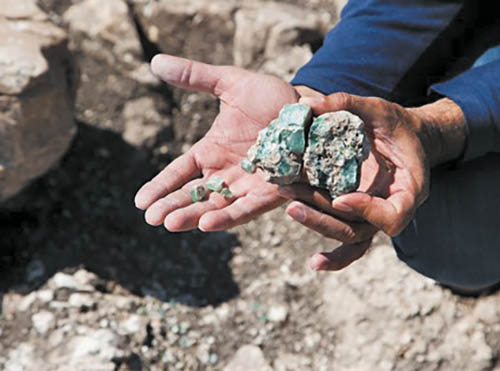
Ordinarily, a piece of broken glass lying on the ground is unsightly litter at best, a danger to bare feet and pets at worst. But not in the Middle East—there a piece of broken glass has the power to ruin decades of political propaganda. Pro-Palestinian propaganda, that is.
Case in point: this week’s discovery of the world’s oldest glass kilns, alongside a railroad track at the foot of Mount Carmel, near Haifa.
Dr. Yael Gorin-Rosen, the head curator of the Israel Antiquities Authority’s Glass Department, announced that the Mount Carmel diggers had come across pieces of broken glass, which in turn revealed full-fledged glass kilns—”a very important discovery with implications regarding the history of the glass industry both in Israel and in the entire ancient world.” Professor Ian Freestone, of London’s University College, a specialist in the identification of the chemical composition of glass, declared the Mount Carmel glass “a sensational discovery.” Glass researchers from around the world are flying to Israel to view it first-hand.
Why all the fuss? Well, it turns out that years ago, the glass-history experts carried out chemical analysis of glass objects that were found in Roman-era shipwrecks in the Mediterranean. The tests showed that the glass originated in the Acre (Akko) valley, in the northern part of the Land of Israel. But nobody had ever located the actual kilns where the raw materials were processed to create that glass. Until now!
Now all of this might seem like pretty boring stuff to anybody outside a handful of archaeologists and their fellow travelers.
But, in fact, it’s a vivid and powerful affirmation of Zionism and deals a devastating blow to the Palestinian Arab cause.
To begin with, the kilns reveal—according to Prof. Freestone—that “Israel constituted a production center on an international scale—hence its glassware was widely distributed throughout the Mediterranean and Europe.”
Why is that such a big deal? Because the archaeologists have determined that the kilns are about 1,600 years old. That means they were in use around the year 400 CE, in the late Roman period.
Think about that. The Romans destroyed the Second Temple in the year 70 CE. The Bar Kochba rebellion was crushed in 135 CE. An estimated 600,000 Jews were killed. More than 1,000 Jewish cities and towns were destroyed. The popular assumption is that this catastrophe of murder, displacement and exile meant the end of any meaningful Jewish society in the Land of Israel.
Not so fast! Evidently it was no simple matter to sever the ties that bind the Jewish people to the Land of Israel. Because, as the glass discoveries demonstrate, within a relatively short amount of time, the Jewish community in the Land of Israel was (among other things) serving as a glass-production center that exported its products throughout the Roman Empire.
Note: There was no “Palestinian” glass-production center in the country. There weren’t even any Muslims in the country; Islam was not founded until the seventh century CE.
And it turns out that much of what glass historians know about Roman glass is based on a 4th-century (CE) decree by an early Roman emperor named Diocletian. His edict, carved on stone tablets, set the prices for the two types of glass used in the empire. One type was called “Alexandrian Glass,” because it originated in the Egyptian city of Alexandria. The other was called “Judean glass.”
Not “Palestinian glass.” Judean glass. Because everyone knew that the name of the region was Judea. That’s what the Bible called it. That’s what historians called it for more than 2,000 years.
Contemporary Palestinian propagandists have tried to bury the name “Judea.” They prefer the de-Judaized term “West Bank.” But until a few decades ago, nobody ever used the phrase “West Bank.” Do you know why? Because it has no historical basis, no legal basis and no real geographical basis—since most of it is miles away from the western bank of the Jordan River.
Just a few weeks ago, Israeli archaeologists discovered two seals that were used for sealing documents in the 7th or 8th centuries BCE, that is, some 2,700 years ago. The writing on them was Hebrew, not Arabic. One bore the name of a man, “Sa’adyahu ben Shebnayahu”; the other had the name of a woman: “Elihanah bat Goel” (or Gael). The archaeologists noted that the construction of the names were “in typical Judean fashion for this time period.”
There it is again: Judean. Not “Palestinian.”
I look forward to seeing the Sa’adyahu ben Shebnayahu and Elihanah bat Goel seals when they go on display. And I hope to see the Mount Carmel glass, when it is exhibited at the Carmel Zvulun Regional High School later this year.
Yes, I know it’s only a piece of broken glass. But really, it’s so much more.
By Stephen M. Flatow
Stephen M. Flatow, an attorney in New Jersey, is the father of Alisa Flatow, who was murdered in an Iranian-sponsored Palestinian terrorist attack in 1995.













